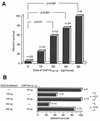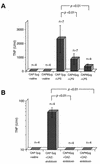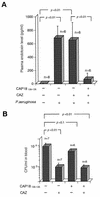Protective effects of a human 18-kilodalton cationic antimicrobial protein (CAP18)-derived peptide against murine endotoxemia
- PMID: 9573062
- PMCID: PMC108136
- DOI: 10.1128/IAI.66.5.1861-1868.1998
Protective effects of a human 18-kilodalton cationic antimicrobial protein (CAP18)-derived peptide against murine endotoxemia
Abstract
CAP18 (an 18-kDa cationic antimicrobial protein) is a granulocyte-derived protein that can bind lipopolysaccharide (LPS) and inhibit various activities of LPS in vitro. The present study examined the protective effect of a synthetic 27-amino-acid peptide (CAP18(109-135)) from the LPS-binding domain of CAP18 against antibiotic-induced endotoxin shock, using highly LPS-sensitive D-(+)-galactosamine (D-GalN)-sensitized C3H/HeN mice. The antibiotic-induced endotoxin (CAZ-endotoxin) was prepared from the culture filtrate of Pseudomonas aeruginosa PAO1 exposed to ceftazidime (CAZ). Injection of CAP18(109-135) protected the mice injected with LPS or CAZ-endotoxin from death and lowered their tumor necrosis factor (TNF) levels in serum in a dose-dependent manner. Treatment with CAZ caused death of the D-GalN-sensitized P. aeruginosa PAO-infected mice within 48 h, while injection with CAP18(109-135) rescued the mice from death. In the mice rescued from death by injection with CAP18(109-135), endotoxin levels in plasma and TNF production by liver tissues were decreased but the numbers of viable infecting bacteria in their blood were not decreased significantly and remained at the levels in CAZ-treated mice. These results indicate that CAP18(109-135) is capable of preventing antibiotic-induced endotoxic shock in mice with septicemia and that the effect is due to its LPS-neutralizing activity rather than to its antibacterial activity.
Figures






Similar articles
-
Biological activities of lipopolysaccharides of Proteus spp. and their interactions with polymyxin B and an 18-kDa cationic antimicrobial protein (CAP18)-derived peptide.J Med Microbiol. 2000 Feb;49(2):127-138. doi: 10.1099/0022-1317-49-2-127. J Med Microbiol. 2000. PMID: 10670563
-
Cathelicidin family of antibacterial peptides CAP18 and CAP11 inhibit the expression of TNF-alpha by blocking the binding of LPS to CD14(+) cells.J Immunol. 2001 Sep 15;167(6):3329-38. doi: 10.4049/jimmunol.167.6.3329. J Immunol. 2001. PMID: 11544322
-
Structure and functions of endotoxin-binding peptides derived from CAP18.Prog Clin Biol Res. 1995;392:317-26. Prog Clin Biol Res. 1995. PMID: 8524937
-
Evaluation of antimicrobial and lipopolysaccharide-neutralizing effects of a synthetic CAP18 fragment against Pseudomonas aeruginosa in a mouse model.Antimicrob Agents Chemother. 1998 Dec;42(12):3269-75. doi: 10.1128/AAC.42.12.3269. Antimicrob Agents Chemother. 1998. PMID: 9835525 Free PMC article.
-
Biological characterization of endotoxins released from antibiotic-treated Pseudomonas aeruginosa and Escherichia coli.Antimicrob Agents Chemother. 1998 May;42(5):1015-21. doi: 10.1128/AAC.42.5.1015. Antimicrob Agents Chemother. 1998. PMID: 9593119 Free PMC article.
Cited by
-
Differential host inflammatory responses to viable versus antibiotic-killed bacteria in experimental microbial sepsis.Infect Immun. 2000 Apr;68(4):2301-8. doi: 10.1128/IAI.68.4.2301-2308.2000. Infect Immun. 2000. PMID: 10722633 Free PMC article.
-
Structure-function analyses involving palindromic analogs of tritrypticin suggest autonomy of anti-endotoxin and antibacterial activities.Protein Sci. 2008 Mar;17(3):545-54. doi: 10.1110/ps.073145008. Epub 2008 Jan 24. Protein Sci. 2008. PMID: 18218719 Free PMC article.
-
Expression of LL-37, human beta defensin-2, and CCR6 mRNA in patients with psoriasis vulgaris.J Huazhong Univ Sci Technolog Med Sci. 2004;24(4):404-6. doi: 10.1007/BF02861879. J Huazhong Univ Sci Technolog Med Sci. 2004. PMID: 15587410
-
Regulation of the Immune Balance During Allogeneic Hematopoietic Stem Cell Transplantation by Vitamin D.Front Immunol. 2019 Nov 5;10:2586. doi: 10.3389/fimmu.2019.02586. eCollection 2019. Front Immunol. 2019. PMID: 31749811 Free PMC article. Review.
-
Alterations in vitamin D status and anti-microbial peptide levels in patients in the intensive care unit with sepsis.J Transl Med. 2009 Apr 23;7:28. doi: 10.1186/1479-5876-7-28. J Transl Med. 2009. PMID: 19389235 Free PMC article.
References
-
- Atlas R M. Handbook of microbiological media. Boca Raton, Fla: CRC Press; 1993.
-
- Bucklin S E, Morrison D C. Differences in therapeutic efficacy among cell wall-active antibiotics in a mouse model of gram-negative sepsis. J Infect Dis. 1995;172:1519–1527. - PubMed
Publication types
MeSH terms
Substances
LinkOut - more resources
Full Text Sources
Other Literature Sources
Medical

